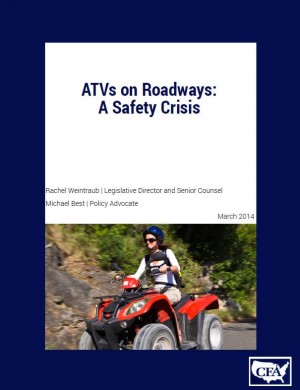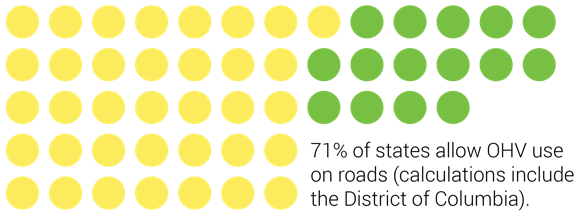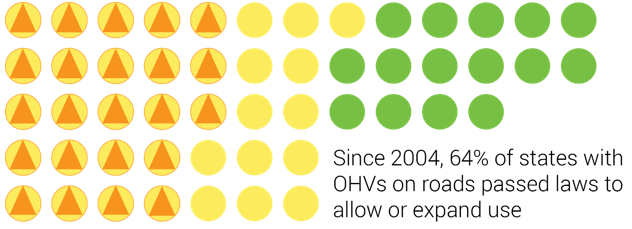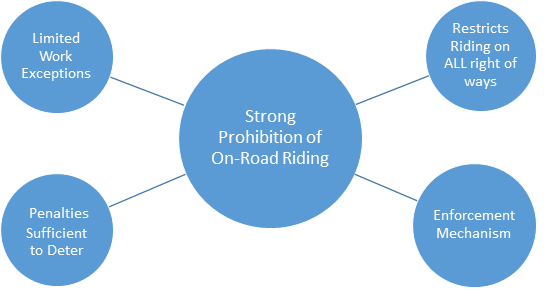Off-Highway Vehicles on Roads
Our initial report ATVs on Roadways: A Safety Crisis was focused on state and local laws allowing ATVs on roads but our data collection efforts revealed that a significant number of ROV deaths were also occurring on roads, and we conducted the research to show that wherever the law allowed ATVs on roads or for localities to allow ATVs on roads that ROVs were also allowed access.
Despite the weight of industry and consumer advocate warnings, and the sobering data that indicates most ATV deaths and a significant number of ROV deaths occur on roads, the majority of states allow OHVs to be driven recreationally on public roads under certain circumstances or with local approval.
36 states either allow OHVs on certain roads, roads as authorized by the entity having jurisdiction over the road system, limited stretches of roads, or roads if certain requirements are met, or on the shoulder of roads.
Since 2004, 23 states have enacted laws increasing legal OHV access to roads in some way—four states in 2013 alone.
32 of the 36 states that allow OHVs on roads delegate some or all of the decisions about OHV access to local jurisdictions with authority over those roads.
As many of the decisions to allow OHVs on roads are being made at the local level, our OSC tracks state and local proposals to increase OHV access to roads and sends letters to local decision makers urging them not to adopt such proposals and explaining why it is so dangerous to operate OHVs on roads.
Danger is not only on Paved Roads
Some state laws allow OHV use on unpaved rather than paved roads (such as in Florida), and OHV industry and association warnings are focused on the dangers of riding on paved roads. But a 2015 study published online in Traffic Injury Prevention, All-Terrain Vehicle Fatalities on Paved Roads, Unpaved Roads, and Off-Road: Evidence for Informed Roadway Safety Warnings and Legislation, studied ATV on-road fatalities and makes it clear that riding ATVs on roads is unsafe whether the roads are paved or unpaved.
An earlier study found that over 60% of all U.S. ATV-related fatalities involved roadway crashes. ATV roadway deaths also increased at twice the rate of off-road deaths from 1998-2006, making on-road ATV riding a deadly behavior.
This latest study shows that from 1982 through 2012, 42% of the total 6,625 roadway deaths occurred on unpaved roads and found twenty three states with half or more of their ATV roadway deaths on unpaved road surfaces.
The study finds that safety warnings should explicitly state the dangers of roadway riding regardless of the road surface type and supports the need for laws and ordinances restricting ATV riding on all types of roadways.
Coalition Efforts to Educate Local Decision Makers
As the majority of state laws allowing OHVs on roads do so by delegating authority to localities, our coalition has worked to identify where towns or counties are proposing to increase OHV access to roads and send letters urging local decision makers not to endorse this dangerous behavior by making it legal
Since CFA began monitoring OHV on roads proposals in late 2013 we are aware of 73 proposals—predominately at the local level.
70 OHV Letters Sent Since April 2014
Since April 2014 CFA has sent 70 letters to:
- 10 separate state level political entities;
- 26 counties;
- 2 Forest Service officials;
- 27 cities and towns;
The OSC has sent 70 letters across 21 states with large concentrations in Washington State (14) and Iowa (12). All of the OSC’s letters to local decision makers, are available organized by state.
Need for Strong prohibitions against OHVs on Roads
States and localities need to signal to citizens that OHVs are not safe or suitable for on-road use with strong laws that restrict all recreational OHV riding on all portions of a right-of-way, have few exceptions to that general rule, and will provide for consequences for violating the law.
There are States with Strong OHV Road Laws
Delaware has a strong law prohibiting OHV use on roads:
- OHVs Prohibited on entire Right of way—no riding on shoulder of road
- Only allows OHVs on roads for parades or other special activities
- No Work exceptions
- No crossing roads—OHVs must be pushed across roads
- Fines and impoundment
- Police may impound to stop violation of law
- First offense: $100
- Second Offense: $400 and mandatory 6 month impoundment
Resources
- CFA Report
 : This report analyzes the law regarding ATV use on roads in 50 states and the District of Columbia and shows a trend toward states legalizing, and implicitly endorsing, ATV use on roads. CFA calls for immediate action at the municipal, county, state, and federal level to prohibit ATVs on roadways.
: This report analyzes the law regarding ATV use on roads in 50 states and the District of Columbia and shows a trend toward states legalizing, and implicitly endorsing, ATV use on roads. CFA calls for immediate action at the municipal, county, state, and federal level to prohibit ATVs on roadways.
- IIHS Report: IIHS analyzed data from the National Highway Traffic Safety Administration’s Fatality Analysis Reporting System, which has data about on-road ATV-related deaths. IIHS found that during the period 2007-2011, there were 1,701 ATV rider deaths in on-road crashes.
- Denning, Harland, Ellis, Jennissen, Article in Injury Prevention: Over 60% of all fatalities (1985–2009) resulted from roadway crashes.
- Jennissen, Harland, Wetjen, Peck, Hoogerwerf, Denning, Article in Annals of Family Medicine: At least 75% of students reported having been on an ATV, and most riders engaged in risky behaviors, including riding on public roads (81%).
- ATV Safety Institute’s Golden Rules: Rule number two warns riders to never use ATVs on paved roads.
- CPSC ATV Safety Page: A variety of ATV safety information and statistics.
- IIHS ATV Fatality Facts: Deaths of ATV riders on public roads have increased dramatically in the last 30 years.
- NACCHO Podcast Series Rachel Weintraub on ATV Safety Podcast (March, 2015): On this week’s episode Senior Program Analyst Alyssa Banks interviews Consumer Federation of America’s Rachel Weintraub on emerging safety issues associated with all-terrain vehicles or ATV’s. The interview highlights national trends as well as policy and prevention opportunities for local public health
- Centre for Automotive Safety Research: Quad bikes are a leading cause of death and serious injury on Australian farms. This study provides important insights regarding quad bike use and the circumstances surrounding incidents that occur as a result of their use.





